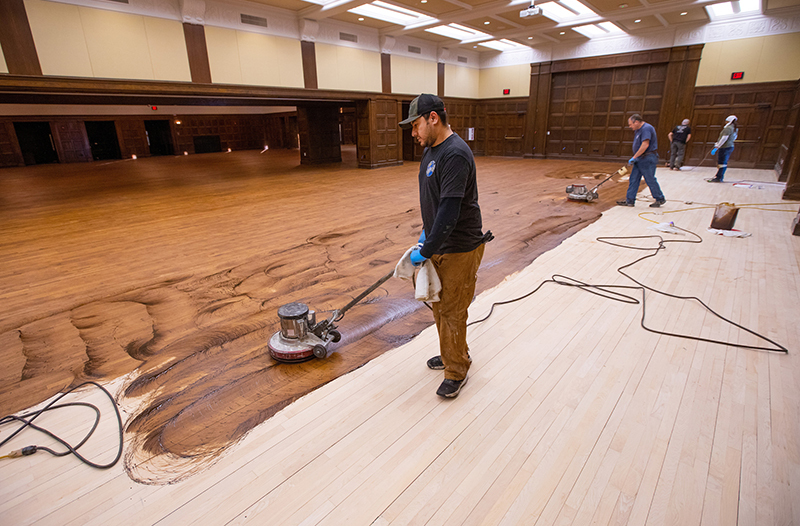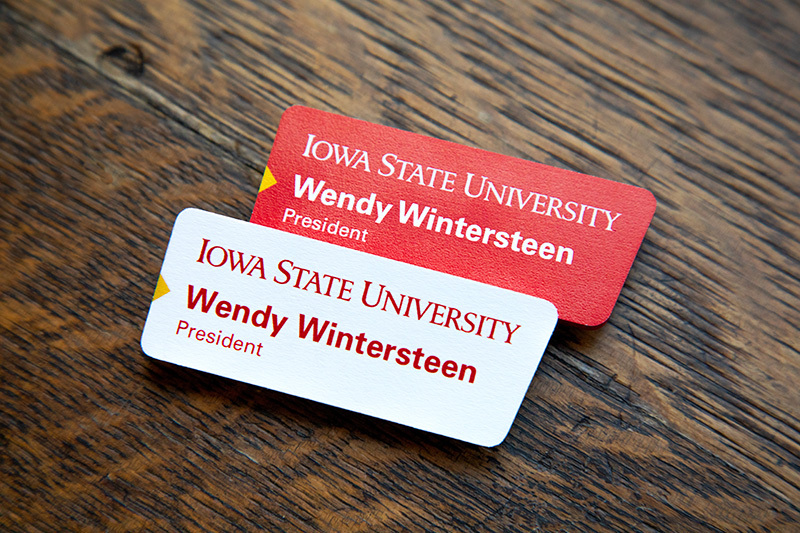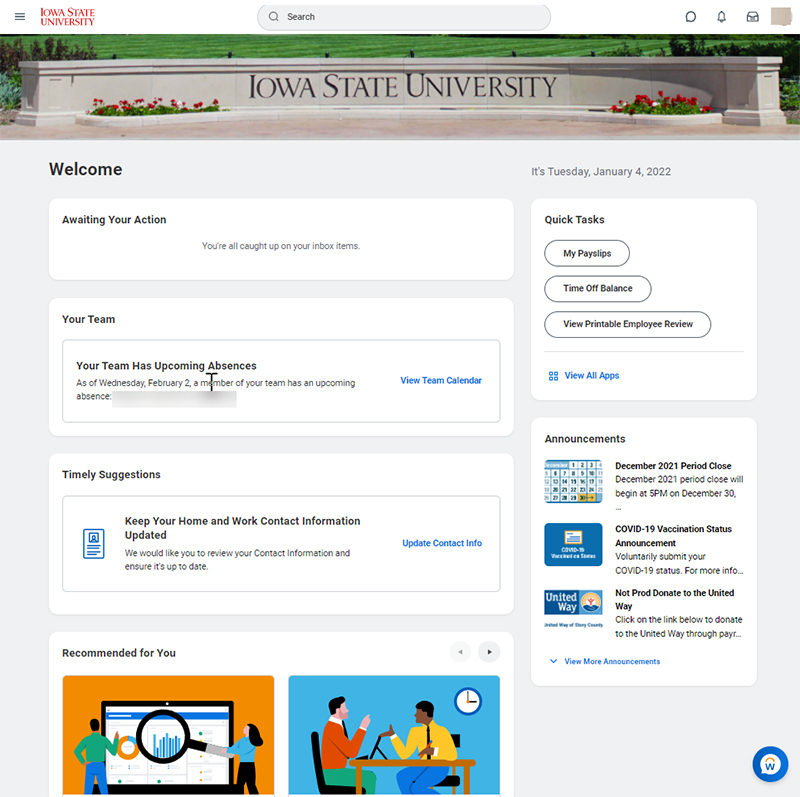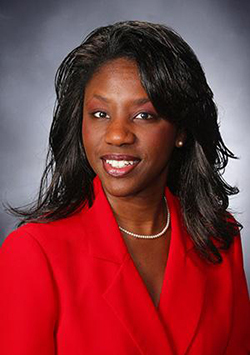Strategic use of some quiet weeks

Photo by Christopher Gannon.
A crew from Barnum Floors, Des Moines, applies stain to the Memorial Union South Ballroom earlier this week as part of a project to strip, sand and refinish 19,000 square feet of hardwood floor covering the ballroom, Durham Great Hall and the Sun and Oak rooms.
Their work kicked off Dec. 20 immediately after graduation weekend and is on track to be finished by Friday Jan. 7. The new finish should endure for about 50 years, but this is the final time the original wood floor can be sanded.
The floor project is part of a larger plan to refurbish the Great Hall. Painting has been completed. Another piece in the works this month is replacing and modernizing the overhead theater lighting and set systems and curtain rigging in the stage area. Following demolition the last week of December, reconstruction started this week and will continue through January. Great Hall events will continue, with the front stage curtains shielding the construction zone from the rest of the room. A final item in the Great Hall restoration, new stage curtains, will arrive in April.
The contractor for the project is using the Col. Pride lounge as a staging and storage area, so that room is unavailable for university use this month.
Elsewhere in the Memorial Union, the third-floor bathrooms are renovated and compliant with accessibility standards and will reopen by the end of this week. While it's closed for the semester break, the Maintenance Shop also is getting a sprucing up, with new paint, flooring, stage carpet and bar top and additional display monitors. And the 15-month effort to renovate floors 4 through 6 for seven student-serving units remains on schedule for early May move-in.
Name badges now available through printing services

Printing services is producing redesigned name badges, available to faculty and staff through online order. Orders come in sets of two badges -- one red, one white. Photo by Christopher Gannon.
Iowa State employee name badges have been redesigned. Printing services added equipment to produce items like name badges, and university marketing worked with director Nathan Thole on the design to bring production inside the university.
University marketing director Carole Custer said durability, texture, finish, color and ability to handle alternative text were key considerations in the yearlong redesign. Thole worked to find material that isn't too shiny, avoids chipping and is readable from multiple angles.
Questions?
Any questions about name badges can be sent to printing services at print@iastate.edu.
"In the last three years, we added some flatbed printing equipment that allowed us to get into this type of product," said Thole, who noted the equipment also produces the Braille signage across campus. "We ended up with a solid red university cardinal (Pantone 186 C) and solid white foamed-PVC that was cost effective, and even if it chips the color is solid all the way through, so you don't see it."
Name badges are the latest item printing services has expanded into in recent years to serve the campus community.
The badges
Name badges for faculty and staff range from basic to detailed according to a person's preference. At a minimum, badges include an ISU wordmark and the employee name. There are two choices for the wordmark: the primary "Iowa State University of Science and Technology" or the abbreviated "Iowa State University."
Options are available to include a person's department, title and preferred pronouns. The badge size is dictated by the amount of information on it. The badge affixes to clothing with a magnet.
Employees can place orders online. If members of a department or unit desire uniformity in their name badges, Thole encouraged employees to begin the process with a conversation with the unit's leader(s).
Employees may continue to use their current name badge.
"The new name badges are very nice, and collaborating with printing services allowed us to uplift that part of our brand around innovation," said Jacy Johnson, associate vice president for strategic relations and communications. "We always want to look internally first when units within the university are capable and cost effective."
An order includes two name badges -- one red, one white -- and costs $21. A design proof is provided within a day or two, and any additional changes after that cost $8.30. It takes five to seven working days to fill an order.
"We typically pool orders together to do one or two runs per week unless someone needs a name badge in a rush," Thole said.
Johnson said name badges are ideal for any employee who represents the university in front of a group.
"Those small touchpoints do make an impression over time for the university," she said.
Meet Workday's new landing page, coming Jan. 10
Starting Monday, employees logging in to Workday will see a new landing page that puts relevant reminders, approaching deadlines and their frequently accessed tasks in front of them. The familiar field of application icons that dominated the right half of the site is available in a new navigation menu.
The intent is to help employees find information about themselves and use self-service tasks that have been in Workday since day one but perhaps were difficult to uncover. The change is part of regular upgrades provided by Workday for its clients.
"It's really about personalizing the landing page for each employee and what's relevant to you -- whether you're an employee or a manager," said change manager Scott Butterfield, information technology. "Workday is focusing on improving the user experience and making an employee's information more visible so it's easier for them to manage their employment at Iowa State."
For example, an employee's upcoming time off will display on the landing page. Or, when a new pay slip becomes available, that message displays for a few days.
Virtual help center
Jan. 10 and 12 (8 a.m.-5 p.m. daily)
Webex Room
Workday has added machine-learning algorithms to recognize the tasks and applications each user accesses most often and displays those on an employee's landing page. After several weeks of use, employees should notice changes in what displays on their landing pages.
Components of the landing page
Workday presents information in several tiles on the landing page:
- Awaiting your action, formerly the in-box. It displays up to three tasks the employee needs to act on, with direct links to them.
- Timely suggestions (new), employee-specific action items, for example, employees who are required to track their time see their time clock status (checked in or out).
- Quick tasks, provides links to the three tasks a user accesses regularly. A "view all apps" option beneath the three opens to the entire list.
- Announcements, university content remains largely unchanged, but the location moves lower on the page.
- Supervisors will see an additional tile, Your team, which displays reminders about their employees' upcoming or current time off, time tracking, anniversaries, etc.
Here's a summary of several other key changes to the Workday landing page.
Search function enhanced
Learn more in these 3-minute videos:
The search function at the top of the Workday landing page provides results within categories employees select for filtering their search results. Enhancements to the search function should provide more accurate results, and starting Jan. 10, employees will be able to customize -- and shorten -- those filters to better fit their needs. The search page also lists prefixes to use in quick, efficient searches.
Applications, shortcuts move to new navigation menu
A new navigation menu to the left of the ISU wordmark lists all Workday's applications -- time and absence, procurement, benefits, for example -- formerly displayed as icons on the landing page. The navigation menu is on every Workday page, not just the landing page. Employees who use Workday's shortcuts option (the foursquare icon) or configure applications option (cog icon) will find those options in the navigation menu. Shortcuts set previously in Workday will show up in this menu Jan. 10.
Get help from a chatbot
Another new feature, Workday assistant, functions as a chatbot to help employees retrieve personal information, for example, details about benefits, payroll, personal data, time off and time tracking that are unique to them. Hourly and nonexempt employees can use it to clock in. The assistant is visible in the lower right corner of every Workday page: a blue W inside a blue ring.
As use of Workday assistant expands over time, users should expect the relevance of the assistant's answers to strengthen due to the machine-learning algorithms.
"We'll monitor this to see how employees use the assistant," Butterfield said. "When we have more information about what they're seeking help with, we'll be able to offer tips on best uses."
Questions? Get answers Jan. 10 and 12
If you have questions or concerns about the changes to your Workday landing page, drop in during the virtual help center on Jan. 10 and 12 (8 a.m.-5 p.m. daily). Members of the Workcyte change management team will host it in a Webex personal room. Or, you can send questions anytime to workcyte_feedback@iastate.edu. A new knowledge-base article in the IT service portal also introduces features of the new landing page.
Pilot and demos
UHR central staff and HR delivery staff have been using the new landing page since December to become familiar with it and be a resource for employees they support on Jan. 10, when the rest of campus sees it. Workcyte's change management team also has demonstrated the landing page to leadership and user groups across campus, including IT leadership team, finance delivery leadership team, time keepers for nonexempt employees, the technical enterprise advisory committee and job management support employees who assist departments with student employment tasks in Workday.
A peek at the landing page

Workday's new landing page
Anti-trafficking law impacts lodging providers, ISU employees
ISU employees must add a step to their to-do list for reserving lodging during travel in the state.
As of Jan. 1, all in-state lodging providers must complete the state Department of Public Safety's human trafficking prevention training to receive public funds for state employee lodging, conferences, meetings, banquets or any state-funded event.
Employees
The law doesn't create additional paperwork for employees. Questions can be directed to finance_delivery@iastate.edu.
"It impacts employees who use state funds to pay for lodging," said Heather Paris, associate vice president central finance and finance delivery. "It really focuses on general funds and state grants. This does not apply to out-of-state travel."
The law (Iowa Code 80.45A) -- which applies to all state agencies -- was passed in 2020 and impacts approximately 1,500 businesses in Iowa that pay Iowa hotel/motel taxes. If a lodging provider is not certified when state funds are used, employees will not be reimbursed for expenses.
The biggest impact will be felt by ISU Extension and Outreach staff, who frequently travel across the state, Paris said.
Airbnb and Vrbo locations must be certified because individual hosts are considered lodging providers. The law also requires compliance for conferences, meetings or banquets if the provider has lodging, regardless of whether an employee stays there.
Funds that can be used with a noncertified provider include federal sources, states other than Iowa and donations.
Additional information, including an FAQ, is available on the controller's department website with links also on the finance service delivery and procurement services websites.
How to know
Determining if a lodging provider has completed certification is a mouse-click away. A website lists all certified locations across the state and is updated daily.
Procurement services is contacting all lodging providers the university has contracts with to encourage compliance. Employees who do not see their desired location on the certification list are asked to contact it and encourage compliance before making a reservation.
The online training for employees of lodging providers began in December and is available 24/7. It consists of watching a video in English or Spanish before completing a test. Once every employee has passed the test, the state sends a certificate that providers are asked to prominently display.
All employees of the lodging provider must pass the test before certification can happen, Paris said. "Being up against the holidays made it a bit of a challenge to get to all of their employees, but more locations are being added every day," she added.
About 270 lodging providers are certified, including the Gateway Hotel and Conference Center in Ames, which the university often uses when hosting guests.
All procurement/expense specialists are being trained on the new law and are responsible for reviewing expense reports to ensure compliance.
Perry Fantini named vice president for diversity, equity and inclusion

Perry Fantini
Sharon Perry Fantini from Tiffin University, Ohio, has been named the next vice president for diversity, equity and inclusion following a national search. Perry Fantini, who serves as vice provost for equity, access and opportunity and Title IX coordinator at Tiffin University, will begin at Iowa State on Jan. 18, 2022.
Her appointment is pending approval by the state Board of Regents.
"Dr. Perry Fantini is a passionate and proven leader with a deep commitment to building collaborative partnerships," said President Wendy Wintersteen. "She brings an excellent set of skills and experience that will help us move Iowa State forward to become a leader in having a welcoming and inclusive environment for our increasingly diverse campus community to succeed and thrive."
Perry Fantini has been in her current position at Tiffin University since 2009 and also serves as an associate professor of management. She is a member of the Association of Title IX Administrators advisory board; the external advisory board for diversity and inclusion for Clarkson University, Potsdam, New York; and the Society for Human Resource Management.
Perry Fantini holds bachelor's degrees in organizational management and human resources management and an MBA from Tiffin University and a Ph.D. in human resources and organization management from Minneapolis-based Capella University.
"It is an honor to join a team that embodies the same purpose I do -- fostering an inclusive campus climate in which every member of the community can thrive in a safe and welcoming environment by embracing, supporting, including and valuing our unique diversity and cultural differences," said Perry Fantini. "The opportunity to join an institution with a dedicated focus on advancing diversity, equity and inclusion within its organizational mission is one I am excited about."
In making the announcement, Wintersteen thanked interim vice president Charles Small for his leadership and members of the search committee and campus community for their thoughtful consideration of candidates.
Editor's note: This story was first shared with the ISU community Dec. 20, the date of the announcement.
Student loan forgiveness temporarily easier for public workers
Full-time public employees, including ISU faculty and staff, will have an easier time accessing the Public Service Loan Forgiveness (PSLF) program under temporary rules effective through next fall, changes that could wipe out more than $4 billion in student loan debt nationwide.
PSLF is a program that Congress created in 2007 to incentivize working in the public sector. Qualifying borrowers who regularly make income-based payments on a student loan through the federal Direct Loan program can be eligible for loan forgiveness in 10 years, after making 120 eligible monthly payments.
Watch out for student loan scams
Borrowers should take care to avoid scams as they explore student loan forgiveness options. Offers that seem too good to be true often don't deliver. Check out the U.S. Department of Education's advice on avoiding student loan scams.
Or that's how it's supposed to work, anyway. It has proven to be a difficult program to navigate. Even after reforms meant to simplify PSLF's intricate paperwork, applications have about a 2% approval rate. At the time the temporary rules were announced in October, only 16,000 people had loan debt discharged under the program since 2017, when borrowers potentially were first eligible.
Under emergency rules allowed due to the pandemic, the U.S. Department of Education announced in October that it temporarily is waiving some of the program requirements that frequently trip up applicants. For applications filed by Oct. 31, 2022, past periods of repayment count toward the required 120 months even if the loan type or repayment plan wouldn't usually qualify. For example:
- PSLF applicants with loans through the Federal Family Education Loan (FFEL) and Federal Perkins Loan programs typically receive credit only for payments made after consolidating into a Direct Consolidation Loan. The waiver allows pre-consolidation payments toward FFEL and Perkins loans to count for PSLF. Applicants are still required to consolidate into a Direct Loan before applying for forgiveness.
- Payments won't be disqualified for being a day late or a dollar short. As long as the loan wasn't in deferment, default or forbearance, every month in a repayment plan counts toward the 120-month requirement, even if the borrower paid late, paid less than the amount due or didn't make a payment that month.
- The temporary change to the payment rules means that borrowers whose federal student loan payments have been suspended during the COVID-19 pandemic can receive PSLF credit for the duration of the suspension -- which could account for more than one-fifth of the 120 required payments. The suspension period for student loan payments currently is scheduled to expire May 1 after a recent additional extension.
"I can't emphasize enough how life-changing these limited-time changes could be for eligible borrowers," said Lindsey Clark, director of external affairs for Savi, a service from TIAA that can help Iowa State faculty and staff identify student loan repayment and forgiveness options.
Big impact
The waivers are expected to affect tens of thousands of borrowers. The Education Department estimates about 22,000 will immediately be eligible for loan forgiveness without any additional action on their part, which would eliminate about $1.8 billion in debt. About 27,000 borrowers, holding about $2.8 billion in student loans, could qualify for forgiveness by just certifying additional periods of eligible employment.
Nationwide, about 550,000 borrowers who already have consolidated their loans will see their tally of payment months increase, by an average of 23 months. Those updates will be made automatically for borrowers who previously applied for PSLF and certified eligible employment.
Clark said the federal estimate of how many people will be affected by the waiver is conservative, as it doesn't account for borrowers who haven't applied for PSLF previously but are now eligible under the expanded eligibility requirements.
"The impact is truly bigger than we know," she said.
Employment requirements
The waiver doesn’t change what sort of employment qualifies a borrower for the forgiveness program. Applicants still must have worked at least 30 hours per week for the government or a nonprofit that is tax-exempt under section 501(c)(3) of the Internal Revenue Code, which includes most private schools.
However, there is one change for applications submitted during the waiver period. Applicants will be eligible even if they're not working for a qualified employer at the time of the application or when their debt is eventually forgiven. The PSLF program rules usually require applicants to be employed at a qualifying job both at the time they apply and when forgiveness is granted.
How to take action
The Education Department has an online help tool to learn more about applying for loan forgiveness under the PSLF program and generate needed forms, as well as FAQs about the overall program and the limited waiver.
ISU employees looking for assistance as they consider PSLF or other forgiveness options can sign up for Savi. Available since June 1, the service proposes personalized repayment and forgiveness plans based on income, family size, debt amount and employment history. For a commitment-free assessment, employees need to supply some brief information such as their previous year's income and logins for their loan servicing company.
Employees can use Savi's free level to find the forms needed to apply for the recommended programs. Additionally, at the "essential services" level, which costs $60 per year, Savi acts as a student loan repayment concierge, processing all the application forms, employer verification and annual recertifications on an employee's behalf. Essential services clients also receive ongoing monitoring and one-on-one customer support from student loan experts.
For more information, consider joining one of Savi's twice-monthly online student loan forgiveness workshops. January's webinars are Jan. 12 at 1 p.m. and Jan. 26 at 11 a.m.
